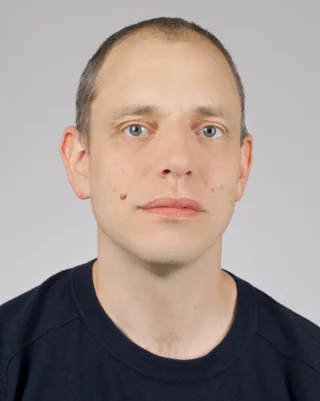Biography
Andreas Menzel received his degrees from the School of Physics and School of Electrical and Computer Engineering at the Georgia Institute of Technoloy in Atlanta, GA. Before joining the Paul Scherrer Institute in 2007 he had held postdoctoral appointments in the Materials Science Division at Argonne National Laboratory, US, working on in-situ structural characterization of catalytic surfaces, and at BESSY in Berlin, Germany, where he characterized magnetic multilayers, among other projects.
Institutional Responsibilities
Andreas Menzel joined the Paul Scherrer Institute in 2007 and has headed the “Coherent X-ray Scattering” group since 2011. He is responsible for the cSAXS beamline at the Swiss Light Source, which he helped to construct and which has been in regular-user operation since 2008. His contributions include instrumental, methodological, and analytical developments that have allowed the beamline to maintain its position as one of the premier facilities worldwide for ptychographic imaging and high-brilliance applications of small-angle X-ray scattering.
cSAXS stands to profit most directly from the SLS upgrade. Accordingly, concepts are being developed to realize and exploit an increase of usable flux by ~4 orders of magnitude.
Scientific Research
Structural investigations in the nano- to micrometer regime often require techniques that exploit characteristics of both imaging and scattering. Andreas's research aims at developing high-resolution and high-sensitivity techniques with particular attention to characterizing statistically relevant ensembles, increasing dose efficiency, and accessing transient states in operando.
Next to cutting-edge applications and performance, his interest is in turning X-ray ptychography into a technique that is useful for and usable by non-specialists. Of special interest are reduction of systematic errors, sampling requirements and rational data acquisition strategies, as well as figures of merit to judge reconstruction reliability. High-brilliance applications of small-angle X-ray scattering include measurements from small volumes, with spatial resolution for imaging applications, with high time resolution for dynamics characterization, or with a combination of these properties and demands.
Selected Publications
For a complete overview, see ORCiD 0000-0002-0489-609X, Web of Science ResearcherID: C-4388-2012, or PSI's publication repository DORA.
X-ray Fourier ptychography
K. Wakonig, A. Diaz, A. Bonnin, M. Stampanoni, A. Bergamaschi, J. Ihli, M. Guizar-Sicairos, and A. Menzel. Science Advances 5 (2019) eaav0282. DOI:10.1126/sciadv.aav0282. The first demonstration of Fourier ptychography using X-rays, in two distinct realizations. We believe such synthetic aperture techniques have potential as a real asset in X-ray microscopy.
Model-free classification of X-ray scattering signals applied to image segmentation
V. Lutz-Bueno, C. Arboleda, L. Leu, M.J. Blunt, A. Busch, A. Georgiadis, P. Bertier, J. Schmatz, Z. Varga, P. Villanueva-Perez, Z. Wang, M. Lebugle, C. David, M. Stampanoni, A. Diaz, M. Guizar-Sicairos, and A. Menzel. J. Appl. Crystallogr. 51 (2018) 1378. DOI:10.1107/S1600576718011032. I worry frequently about the distortions the researchers' biases introduce. How can we avoid finding only what we've been expecting or falling victim to decisions informed
by chance? Here's an attempt to define a routine how to analyze and categorize the rich and voluminous data sets we frequently collect.
Elementary signals in ptychography
J.C. da Silva and A. Menzel. Opt. Express 23 (2015) 33812. DOI:10.1364/OE.23.033812. An early attempt to find and refine rational arguments on sampling in ptychographic data acquisition. This represents a part of my interest in understanding the reliability of ptychography and the circumstances in which it fails to produce reliable results.
Reconstructing state mixtures from diffraction measurements
P. Thibault and A. Menzel. Nature 494 (2013) 68. DOI:10.1038/nature11806. The mixed-state formulation of ptychography helps to address some of the technique's most limiting experimental challenges. Acceptance of some degree of partial coherence and robustness to detector point spread improves reconstruction quality and reliability and makes further instruments useable or a higher flux accessible. In fact, since it only assumes wide-sense stationary fluctuations that can be described by low-rank density, the technique can reconstruct a wide range of steady-state fluctuations in both quantum and classical systems.

